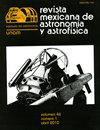CZEV502–狮子座三重态附近的一颗M矮星,具有非常强的耀斑
IF 1.7
4区 物理与天体物理
Q3 ASTRONOMY & ASTROPHYSICS
Revista Mexicana de Astronomia y Astrofisica
Pub Date : 2022-04-01
DOI:10.22201/ia.01851101p.2022.58.01.12
引用次数: 0
摘要
文中介绍了在CzeV502 M矮星上发现的耀斑及其后续观测结果。由于X射线活动,我们将其归类为UV-Ceti型的dMe喷发变量,测量的B−V为1.5 mag,Hα;发射和闪光。我们的监测显示,在58个晚上(210小时)内,只有一只可靠的和一只疑似超级幼虫。ΔR=1.5mag(ΔB≈6-8mg)的最强耀斑的总能量为3E+34erg。ASAS-SN数据可能包含4个事件,最大ΔV为0.43 mag,周期性为12.55 d,对应于旋转或可能的二进制性。天空调查中的其他增亮(ASAS-3、CRTS、NSVS和KWS)值得怀疑。1600块照相底片上没有任何活动。1-2超巨星/1640小时的速率上限对应于比其他M-矮星高几个数量级的活动,尤其是慢旋星。低振幅耀斑(ΔB<0.5 mag)可能很常见(1个耀斑/4小时)。本文章由计算机程序翻译,如有差异,请以英文原文为准。
CZEV502 – AN M DWARF NEAR THE LEO TRIPLET WITH VERY STRONG FLARES
Discovery of flares in the M dwarf CzeV502 and our follow-up results are presented. We classify it as a dMe eruptive variable of UV Ceti type due to the X-ray activity, measured B − V of 1.5 mag, Hα; emission, and flares. Our monitoring revealed only one reliable and one suspected superflare in 58 nights (210 hrs). The strongest flare with ΔR = 1.5 mag (ΔB ≈ 6-8 mag) could have a total energy of 3E+34 erg. The ASAS-SN data may contain 4 events up to ΔV of 0.43 mag and 12.55 d periodicity corresponding to the rotation or possible binarity. Other brightenings in sky survey (ASAS-3, CRTS, NSVS, and KWS) are doubtful. No event was unveiled on the 1 600 photographic plates. The upper rate limit of 1-2 superflares/1 640 hrs corresponds to activity several orders higher than for other M-dwarfs, especially, for the slow rotators. The low amplitude flares ( ΔB < 0.5 mag) may be common (1 flare/4 hrs).
求助全文
通过发布文献求助,成功后即可免费获取论文全文。
去求助
来源期刊

Revista Mexicana de Astronomia y Astrofisica
地学天文-天文与天体物理
CiteScore
1.30
自引率
10.00%
发文量
14
审稿时长
>12 weeks
期刊介绍:
The Revista Mexicana de Astronomía y Astrofísica, founded in 1974, publishes original research papers in all branches of astronomy, astrophysics and closely related fields. Two numbers per year are issued and are distributed free of charge to all institutions engaged in the fields covered by the RMxAA.
 求助内容:
求助内容: 应助结果提醒方式:
应助结果提醒方式:


